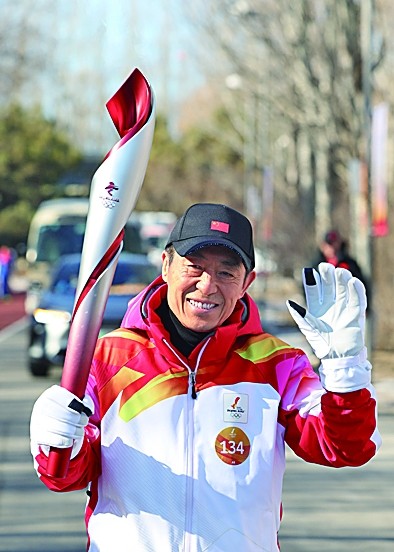

On the evening of February 4th, the last surprise in the opening ceremony of the Beijing Winter Olympics was revealed; mysteries surrounding what Zhang Yimou, the ceremony’s chief director called “an unheard-of flame lighting session in the hundred-year-long history of the Olympic games” were finally unveiled. Instead of lighting up an inferno, there was no ignition, and instead of a roaring fire, there was only a “micro-flame.” This design, conveying the ideal of carbon-neutral and environment-friendly Olympics, was unprecedented in the history of Olympic flame lighting sessions.

On February 2, the torch of the Beijing Winter Olympics was passed in the Beijing Olympic Forest Park. The picture shows torchbearer Zhang Yimou during the torch relay.
The way of cauldron lighting is always a tightly guarded secret as well as the climax of each Olympic opening ceremony. In the case of the Beijing Winter Olympics, the designation of the lighting session is not only ingenious, but also with a touch of humor: quite early in the “Snowflake Building” section, snowflake-shaped guide cards were combined into a giant snowflake outlined with interwoven olive branches. For a long time, this huge “snowflake” was hanging high in the centre of the National Stadium, glittering in silver lights. However, it was not until the last moment that the audience realized that the main cauldron turned out to be no other than this giant snowflake, the form of which captured as well as subverted the public imagination about a “main torch.” The ignition session has maximally implemented the idea of holding a low-carbon, environment-friendly Olympic game.
The two major innovations in the lighting session, namely, the shape of the main cauldron and the way of its ignition, demonstrate cultural confidence of the Chinese people of the new era. Through such designs, the main design team of the opening ceremony wish to tell a story about China as well as to deliver to the world a shared ideal of mankind.
As the director Zhang Yimou noted, “Previous main cauldrons were designed mainly to fulfill two expectations: to show the cultural characteristics of the host country, and to be innovative. We are the first to write down the names of all the participating countries on the torch.” He further explained, “‘Snowflake’ had become a keynote since the countdown: the guides entered the stadium in uniforms with snow-and-ice patterns, holding snowflake-shaped boards. With each representing a country or a region, snowflakes from all over the world converged in Beijing and merged into a most dazzling one. This huge snowflake eventually became the unique torch of this Winter Olympics, with the names of all participating countries and regions left on it.”
For both the fire-in-water design of the 2000 Sydney Olympics opening ceremony and the “trapeze” design of the 2008 Beijing Olympics, the ultimate effect of the main cauldron was blazes. “From the Olympics to the Paralympics, this fire lasted for more than a month, and a tremendous amount of fuel was being consumed every minute. Flaming torch is certainly a symbol of the Olympic spirit, but I cannot help but wonder if this is the best option in terms of its influences on the environment. This time, the last torchbearers did not make a roaring fire; they merely placed their torch on a stand, and the main cauldron was ready. This small flame, bearing the ideal of a carbon-neutral and environment-friendly Olympic game, will continue to be burn for the rest of the Olympic and the Paralympics season. This ignition session will become a classic moment in the history of the Olympic games,” Zhang added.
Regarding the way to light the flame, Zhang further remarked, “The fire collected from the site of ancient Olympia had gone through a long journey before it reached China, and then it underwent a torch relay in China before it finally reached the ‘Bird's Nest.’ The flame must be maintained, since it is a symbol of the undying Olympic spirit that has lasted for over a hundred year, but we designed its last leg differently: the torch is simply placed on a torch stand in the cauldron, and no more fire is lit.”
According to the design team of the opening ceremony, the Beijing Winter Olympic torch utilizes aerospace hydrogen-oxygen engine combustion technology. Compared with traditional propane fuel, hydrogen provides green, environment-friendly and pollution-free energy, but its low density renders it combustible and explosive. If the fuel is not properly handled, the effect of the main torch will be inevitably compromised. Given this, cases of successful usage of hydrogen as torch fuel had been unheard of in the history of Winter Olympics. Thanks to the joint efforts from researchers and the design team, a hydrogen flame stabilizing technology was finally discovered. With a flame chromogenic developer being solidified on it, the burning hydrogen was able to present a warm and bouncing visual effect.
“During the experimental and design process, our research team collected information about the Winter Olympics torches of the past one hundred years, and have benefitted from the experience of various countries. The Olympic torch fuel has evolved from magnesium blocks to propane, and now to pollution-free and zero-carbon hydrogen. Our efforts represent our pursuit of a low-carbon and environment-friendly Beijing Winter Olympics, and our achievements bespeak the scientific and technological strength of our country. The success of the opening ceremony also helps promote China’s hydrogen energy technology in the future. Compared with previous torches, the hydrogen torch reduces energy consumption by approximately 99.9%. Such a design fully demonstrates our ideal of low-carbon and environment-protection,” a member of the research team introduced.
Translated by Yunyi Ma and Men Bozhou, Fudan University
点击右上角![]() 微信好友
微信好友
 朋友圈
朋友圈

请使用浏览器分享功能进行分享
